 Recreation
Recreation
 Boating
Boating
 Sail Boats
Contact
Sail Boats
Contact
Don's Home
 Recreation
Recreation
 Boating
Boating
 Sail Boats
Contact
Sail Boats
Contact
|
|
Sailboat types:
The generic term for the front sail is the headsail, which may be jib or genoa.
Yawl or Ketch vs Sloop Preferably a yawl or ketch rig for those times when the auxilliary collapses and dies around the time I am pulling into a marina, and, for a balanced sail with a little less main. Yawls (normally with headsail(s) can sail any point of the wind without the mains'l. Choosing a Sloop or Ketch | TripsSavvy If you are looking for a cruising sailboat, depending on your preferred size range, you may be choosing between a sloop and a ketch. These are the two most common types of cruising sailboats Advantages of a Sloop
Sloop: A sloop is generally the most common type of sailboat rig. A sloop has a single mast and usually only two sails: the mainsail and a headsail, such as a jib or a genoa. A sloop may also use a racing or cruising spinnaker. Sloops come in all sizes, from 8-foot dinghies to maxi boats over a hundred feet long. A sloop uses what is called a Bermuda or Marconi rig. This is the tall, thin, triangular mainsail that's commonly seen on the waters of popular boating areas. The sloop rig generally is simpler to use and cheaper to build than a ketch rig. Because of the wind and sail dynamics involved, a sloop is almost always faster than other rigs in boats of comparable size, especially when sailing windward. Ketch: A ketch has the mizzen mast (at the stern) smaller than the main mast (called mainmast). To be a ketch, the mizzen mast must be placed forward of the helm, or more precisely of the rudder. If the mizzen mast is aft, we are dealing with a yawl (see below). A ketch always has a mainsail without a jib. A ketch that rigs a jib (triangular sail above) the jib is a Dundee. Yawl: The yawl has the same rigging as the ketch, but the mizzen is called here a tape-cul and it is placed behind the rudder. Often small, it is not used to propel the boat, but to balance the yacht according to the conditions. Placed far back on the boat, it often requires a mallet tail (a kind of bowsprit towards the back) to carry its sheet. It can be fitted with an under-bar for its rigidity. A yawl is often considered a suitable rig for a short handed or single handed sailor. This is because the mainsail is not quite so big to handle and the mizzen (before the days of modern self steering gear) could allow the sails to be trimmed to keep a boat on the same course. Also, handing (taking down) the mizzen is a quick and easy way of reducing sail, In the North of Scotland, yawl is cognate with yole or yoal. There are examples in both Shetland and Orkney, with type and local variations in design. The Shetland boats include foureens and sixareens - the names denote the number of oars they were designed to use. Both also had sailing rigs - usually a single masted dipping lug. A sixareen was typically 24 to 25 feet (7.3 to 7.6 metres)long overall. The foureen was around 20 feet (6.1 metres) overall. Schooner The schooner has at least 2 masts, but can carry more. The masts are either identical in size, or the foremast (foremast) is smaller than the main mast. There are many forms of sail on schooners that the foresail rigged as a mainsail (on a boom) or as a jib with the halyard point on the main mast. Among the known examples of ketch we can quote Pen Duick VI with which Tarbaly won the solo transatlantic race or Joshua with which Moitessier made his famous round-the-world trip Sail boat rigs: The layout of the masts, sails and stays (cables that hold them up) Sail Plans 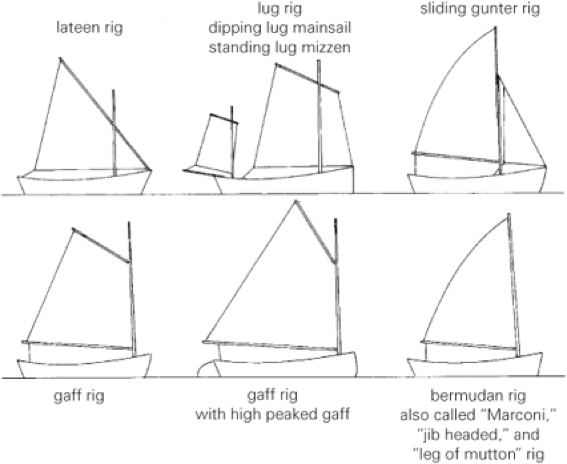
Other Sailboat types: 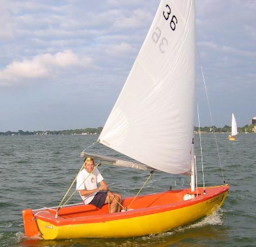 Dinghy - A small open boat Usually rigged with one mast and one sail and offer kids and new sailors simplicity so it’s easy to learn the ropes.
Tech Dinghy (pictured) 20 Best Small Sailboats for the Weekender Catamaran: 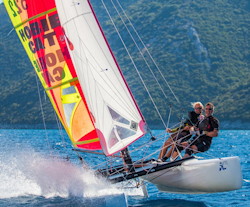 A twin hulled boat. Catamaran sailboats are known for their ability to plane and are faster than single hulled boats (monohull) in some conditions.
A twin hulled boat. Catamaran sailboats are known for their ability to plane and are faster than single hulled boats (monohull) in some conditions.
The ISAF International Class Hobie 16 (H16) (pictured)is a popular catamaran manufactured by the Hobie Cat Company for racing and day sailing.
the Hobie 16 is the second largest boat fleet in existence with over 135,000 boats built to date. 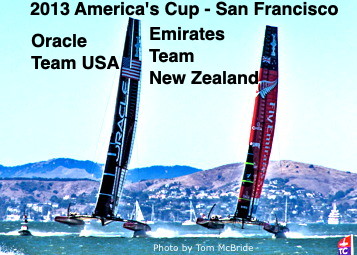 America's cup races:
America's cup races:See America's Cup with details about the 34th America's Cup - San Francisco - 2013 America's cup started in 1851 with 100 ft Scooners then went to 80 ft sloops in 1887 and in 1988 to a 60 ft catamaran. In 1992 they went back to 75 ft monohulls, In 2013 they went to 72 ft. catamarans with hydrofoils. Hydrofoils increased the top speed from around 20 mph to 45 mph. Sailboat Parts: 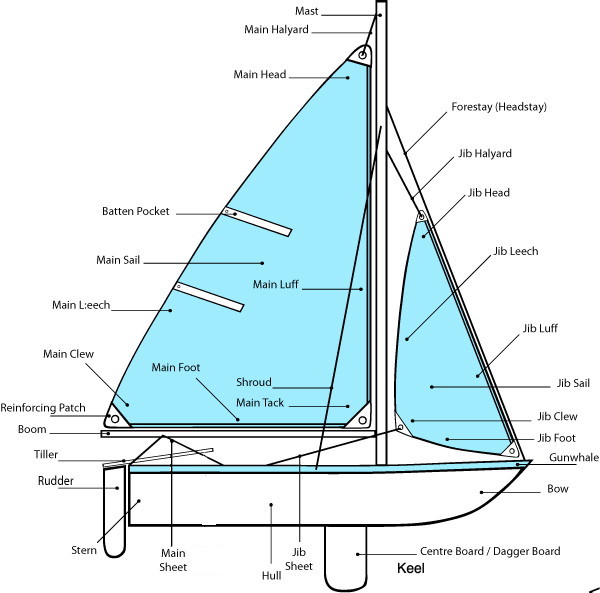
See also Sailing under sports Terms:
Learn to Sail: Part 1: Parts of the Boat and Sailing Terminology | Carpe Diem Sailing YouTube Carpe Diem Sail Training Sailing Terms | L-36
Links: |